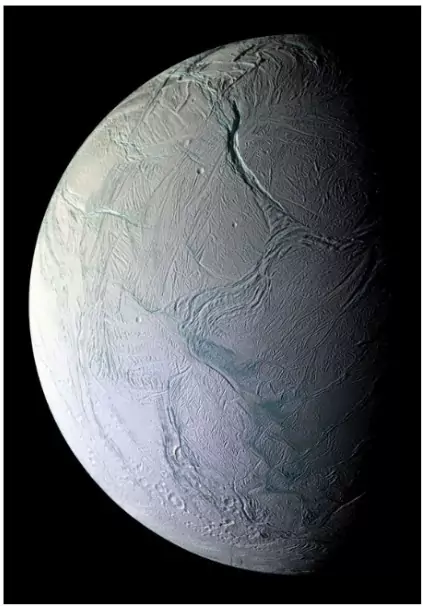A new analysis of data from NASA’s Cassini spacecraft has revealed additional complex organic molecules in the icy plumes of Saturn’s moon Enceladus, strengthening the hypothesis that it could support life.
About Enceladus Moon
Overview
- Enceladus is a small ice-covered moon of Saturn that ejects jets of water vapor and ice particles into space, indicating the presence of a subsurface liquid ocean beneath its icy crust.
 It is one of Saturn’s innermost moons, orbiting at 238,000 km (Saturn’s E-ring) from the planet.
It is one of Saturn’s innermost moons, orbiting at 238,000 km (Saturn’s E-ring) from the planet.- Named after Enceladus, a giant from Greek mythology.
Characteristics
- Diameter: 504 km (313 miles) — about one-seventh the size of Earth’s Moon.
- “Tiger Stripes”: The south polar region contains fissures known as “tiger stripes”, from which geysers erupt due to cryovolcanic activity powered by internal heat.
- Reflective Surface & Tidal Heating: Enceladus is one of the brightest objects in the Solar System (high albedo due to fresh ice). Its tidal interaction with Saturn generates internal heat, sustaining its subsurface ocean.
Discoveries
- Potential for Life: Data from NASA’s Cassini spacecraft detected water vapor, salts, organic molecules, and hydrothermal activity, making Enceladus a leading candidate for extraterrestrial life.
- Enceladus is among a small group of celestial bodies (including Europa and Titan) believed to harbor subsurface oceans with chemical conditions favorable to life.
Cassini–Huygens Mission
- Overview: The Cassini-Huygens mission was a joint venture between NASA, the European Space Agency (ESA), and the Italian Space Agency (ASI).
- Launch: It was launched on 15 October 1997 and reached Saturn in 2004 after a seven-year journey.
- Purpose: To study the planet Saturn and its system, its natural satellites and rings.
- Components:
-
- Cassini Orbiter (NASA): Studied Saturn’s rings, atmosphere, and magnetosphere.
- Huygens Lander (ESA): Huygens landed on Saturn’s largest moon Titan.
- Duration: Operated for nearly 20 years, including 13 years in Saturn’s orbit (2004–2017).
- The mission ended with a controlled descent into Saturn’s atmosphere on 15 September 2017 to prevent contamination of potentially habitable moons.
- During its closest flyby in 2008, Cassini flew directly through the plumes of ice and gas erupting from fissures near Enceladus’s south pole, collecting direct samples of the ejected material.
|
Key Findings of the Study
- Detection of New Organic Molecules: Researchers confirmed and expanded on Cassini’s earlier findings of organic molecules containing carbon, a fundamental element for life.
- Newly identified compounds include precursors of amino acids—the essential components of proteins.
- Several new classes of complex organic molecules were detected, spanning a wide range of chemical structures and properties.
- Possible Biological Relevance: These molecules may act as intermediates in reactions that lead to biologically relevant compounds, such as peptides and proteins.
- However, scientists clarified that such molecules can also form abiotically (without life), through natural chemical reactions under specific conditions.
- Sampling Methodology: Cassini flew directly through Enceladus’ plumes at 64,800 km/h (40,250 mph), collecting fresh ice grains from the subsurface ocean.
- These grains were ejected only minutes before detection — unaffected by cosmic radiation — giving an authentic snapshot of subsurface chemistry.
Indicators of Habitability
- The findings provide strong evidence that all three essential components of habitability exist on Enceladus:
- Liquid water, confirmed by the subsurface ocean and plumes.
- Energy source from hydrothermal vents releasing heat and minerals from the moon’s rocky core.
- Organic elements, carbon-based molecules necessary for life’s chemistry.
- These hydrothermal systems are similar to the deep-sea vents on Earth, where life is believed to have first originated.
![]() 6 Oct 2025
6 Oct 2025

 It is one of Saturn’s innermost moons, orbiting at 238,000 km (Saturn’s E-ring) from the planet.
It is one of Saturn’s innermost moons, orbiting at 238,000 km (Saturn’s E-ring) from the planet.